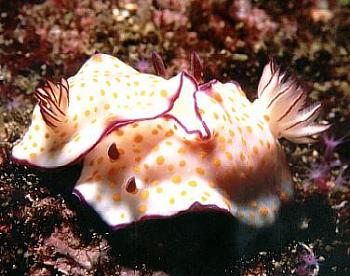
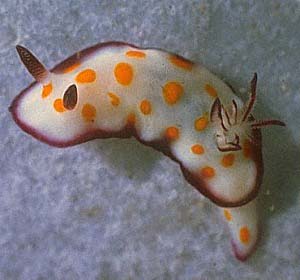
Risbecia ghardaqana
(Gohar & Aboul-Ela, 1957)
Order: NUDIBRANCHIA
Suborder: DORIDINA
Family: Chromodorididae
DISTRIBUTION
Red Sea, Indian Ocean.
PHOTO
UPPER: Musandam, nthn Oman, NW Indian Ocean. September 2000. Photo: Gordon T. Smith.
LOWER: Suakin, Sudan, Red Sea, 10m, May 1980, Photo: C. Todd.
This is one of a number of similarly coloured yellow-spotted species including Risbecia imperialis, Risbecia pulchella, and Chromodoris annulata.
Risbecia ghardaqana occurs sympatrically in the Red Sea, and probably elsewhere in the Indian Ocean, with Chromodoris annulata and Risbecia pulchella. Some confusion has existed on the Forum concerning the identity of the two species of Risbecia. See my message concerning this below. Gohar & Aboul-Ela (1957) reported on the anatomy and developmental biology of these three yellow-spotted chromodorids from Al Ghardaqa, on the Egyptian Red Sea coast,and it was in this publication that Risbecia ghardaqana was recognised a distinct species, which although very similar to the common Risbecia pulchella, differs in a few colour, anatomical and developmental differences. Rudman (1987) placed the species in the genus Risbecia.
Compared with R. pulchella which grows to approx 11cm, R ghardaqana only grows to approx 5.5cm long. The ground colour of the body is white and there are no violet tinged patches. The spots on the mantle and sides of body are yellow not orange and much fewer in number than in R. pulchella. The anterior end of the mantle is not produced into a prominent veil like R. pulchella and the mantle border is bright blue not violet. The gills are simple and although a few may bifurcate they are never as branched as in R. pulchella. They are non vibratile.' The egg-ribbon is white when newly deposited, and the eggs are arranged in one layer rather than two.
References:
• Gohar, H. A. F., & I. A. Aboul-Ela. 1957a. The development of three chromodorids (with the description of a new species). Publications of the Marine Biological Station, Al-Ghardaqa, Egypt, 9: 203-228, pls. 1-5.
• Rudman, W.B. (1984) The Chromodorididae (Opisthobranchia: Mollusca) of the Indo-West Pacific: a review of the genera. Zoological Journal of the Linnean Society, 81: 115-273.
• Rudman, W.B. (1987) The Chromodorididae (Opisthobranchia: Mollusca) of the Indo-West Pacific: Chromodoris epicuria, C. aureopurpurea, C. annulata, C. coi and Risbecia tryoni colour groups. Zoological Journal of the Linnean Society, 90: 305-407.
Rudman, W.B., 2003 (April 8) Risbecia ghardaqana (Gohar & Aboul-Ela, 1957). [In] Sea Slug Forum. Australian Museum, Sydney. Available from http://www.seaslugforum.net/find/risbghar
Related messages
Risbecia ghardaqana from Hurghada, Egypt
October 16, 2007
From: Greg Brown
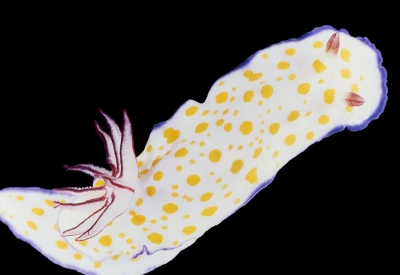
Concerning message #20755:
Hi Bill,
I've been reading the notes and doubts expressed about Risbecia ghardaqana and thought you might like to see a specimen I collected near the type locality whilst working at the Hurghada marine laboratory in 1980. I always took it to be a good match to Gohar & Aboul-Ela's described species although I also found the more common multi-gilled R. pulchella on the same reef within a few hours.
I've attached my photos of the two forms: Upper & middle photos - R. ghardaqana. Lower photo - R. pulchella.
Locality: Hurghada Marine Lab reef front, 10 m, Egypt, Red Sea, 08 April 1980, In daylight on reef rubble . Length: 48 mm. Photographer: Greg Brown (lab photos).
Regards,
Greg
Sally.andGreg7@ntlworld.com

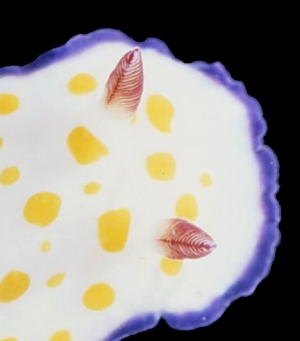
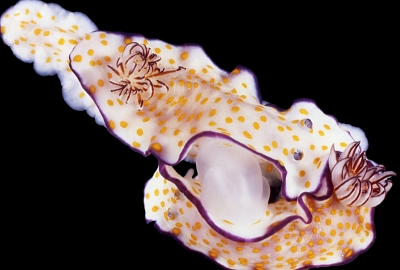
Dear Greg,
Thanks very much for these photos. This is the first photo I have seen of a yellow-spotted chromodorid which matches the original description of R. ghardaqana well. Important features are the small number of simple gills and the lack of any purple background 'smudges' on the mantle.
Since Gohar & Aboul-Ela (1957) discovered the new species while studying the embryological development of large populations of the similarly coloured C. annulata and C. pulchella, I have been puzzled by our inability to find it. Apparently it is must be quite rare, or at least rarely found. It was initially considered a species of Chromodoris, and externally it could easily belong to that genus, but its reproductive system, and the little we know of its radula and jawplates, suggest it is a species of Risbecia. We know nothing of the feeding behaviour of these three yellow-spotted species. It would be good to get photos of them feeding, to see if their choice of sponge matches what we know of their generic relationships.
Best wishes,
Bill Rudman
Risbecia ghardaqana and R. pulchella
April 8, 2003
From: Bill Rudman
Three yellow-spotted chromodorids occur sympatrically in the Red Sea, Chromodoris annulata, Risbecia ghardaqana and Risbecia pulchella. Some confusion has existed on the Forum concerning the identity of the two species of Risbecia so I will try and clarify what we do know about R. ghardaqana.
Gohar & Aboul-Ela (1957) reported on the anatomy and developmental biology of these three yellow-spotted chromodorids from Al Ghardaqa, on the Egyptian Red Sea coast,and it was in that publication that Risbecia ghardaqana was recognised as a distinct species, which although very similar to the common Risbecia pulchella, differs in a few colour, anatomical and developmental differences. Rudman (1987) placed the species in the genus Risbecia and described a further specimen from the Sudanese Red Sea. Since Gohar & Aboul-Ela's publication is not easily available, I have summarised below the main points they noted concerning the external shape and egg ribbon of the three species.
Risbecia pulchella
Multitudinous specimens ... collected during the years 1937 - 1952 from the harbour reefs. .. occurs all year round but most frequent between May to September. .. large and small animals are together in all months. Grows to 10cm fully extended. Upper surface is of a somewhat opaque creamy white, marked by a bluish tinge in irregular areas on the mantle and sides of the foot. All the dorsal surface of the mantle and the foot is covered with yellowish orange spots of irregular shape and different sizes. The mantle margin is fringed with a thin border of bright bluish violet. The tip of the foot may have a similar border. The front of the mantle forms a veil which continuously waves up and down when crawling. The rhinophores have a white stem and blue leaves. The gills are simple and the colour of the edge can vary from violet to orange yellow in a single specimen. The gills are often branched and often wave rhythmically from side to side. When recently spawned, the egg ribbon is reddish orange. The egg ribbon is attached along one edge in a spiral and the free edge is slightly wavy. Development from laying to hatching took 144 hrs -free swimming veligers.
Chromodoris annulata
Does not occur at Al Ghardaqa as abundantly as R. pulchella. Largest animal was 57mm long. Compared with R. pulchella it is wider but not as high. Colour translucent white, with typical purple rings and bright yellow spots. In one case only, the purple ring around the gills was broken posteriorly. The mantle skirt is ample, and edged in purple. The foot has no purple edge unlike R. pulchella and R. ghardaqana in which the edge of the foot, particularly the posterior tip, is lined with purple or deep blue respectively. The gills are triangular in cross section and edged in brown to purple. They rhythmically wave from side to side. The egg-ribbon, in contrast to R. pulchella, is not folded lengthwise when it leaves the genital opening. It is a white creamy colour when newly deposited. The free edge is not wavy. Whole development takes 148 hours. Free swimming veligers.
Risbecia ghardaqana
Among the several hundred specimens of R. pulchella there were a few individuals which matured at a much smaller size and had a quite different egg ribbon. Compared with R. pulchella which grew to 11cm, R ghardaqana only grew to 5.5cm long. The ground colour of the body was white and there were no violet tinged patches. The spots on the mantle and sides of body are yellow not orange and much fewer in number than in R. pulchella. The anterior end of the mantle is not produced into a prominent veil like R. pulchella and the mantle border is bright blue not violet. The gills are simple and although a few may bifurate they are never as branched as in R. pulchella. They are non vibratile. The egg-ribbon is white when newly deposited, and the eggs are arranged in one layer rather than two. Hatching occurs on the 7th day after egg-laying [similar to other 2 species].
Gohar & Aboul-Ela summarised the following differences:
Colour of dorsum:
•R. pulchella - opaque creamy white with bluish tinge in irregular areas, strewn with yellowish orange spots.
•C. annulata - translucent white with yellow spots, and two violet rings.
• R. ghardaqana - milky white with yellow spots.
Maximum size:
•R. pulchella - 110 x 30mm
•C. annulata - 64 x 20mm
• R. ghardaqana - 55 x 13mm
Rhinophore club:
•R. pulchella - long, dark blue with white axis.
•C. annulata - long, conical, deep purple.
• R. ghardaqana - short, reddish violet, with pink red axis.
Mantle margin:
•R. pulchella - bluish violet.
•C. annulata - deep purple.
• R. ghardaqana - deep blue.
Gills:
•R. pulchella - 20-30, almost vertical, vibratile.
•C. annulata - 9-12, vertical and vibratile.
• R. ghardaqana - 9-11, horizontal and non-vibratile.
Egg ribbon:
•R. pulchella - reddish orange, free edge wavy.
•C. annulata - creamy white, with yellow pigment in spawn jelly, free edge not wavy.
• R. ghardaqana - white, free edge slightly wavy, single layer of eggs.
Some of the differences seem rather subtle - 'deep blue' versus 'deep purple' versus 'bluish-violet', but there are a few features which may be valuable in trying to identify the two species of Risbecia from one another. For example, in R. ghardaqana the mantle does not enlarge around the anterior end into a rounded veil, and there are no diffuse purple patches. Also, the gills said to be non-vibratile and to lie out horizontally, and the egg ribbon is white, with a single layer of eggs. Rudman (1987), in reviewing the species of Risbecia, identified a specimen from Sudan [see Fact Sheet] as R. ghardaqana. It fitted Gohar & Aboul-Ela's description in anatomical detail, but differed in having vibratile gills and orange not yellow spots. One problem we have in identifying this species is not knowing how variable it is in colour. As we can see on the Forum, both R. pulchella and C. annulata show considerable colour variation. What would be useful are some photos of the egg ribbons of these two species of Risbecia. Photographs of specimens laying white and orange egg ribbons would be a valuable way of comparing the similarities and differences. Now that we have so much more information on animals from the border between the Pacific and Indian Oceans is just what are the differences between the Indian Ocean R. pulchella and the Pacific Ocean R. godeffroyana. While we only had material from the western Indian Ocean and the Pacific there were real colour differences between the species. However photos from Indonesia and the Andaman Sea suggest we may have a clinal situation rather than an abrupt distinction, but I will leave that problem for another occasion.
Concerning the animals on the Forum that I have previously identified as R. ghardaqana, I am re-identifying all but two lots as R. pulchella. Barbara Phua's photos from Thailand may be R. ghardaqana. There is no distinct purplish markings on the mantle, and there is no distinct widening of the mantle at the anterior end. The edge of the mantle looks more blue than purple, but that is a risky distinction to make. Another possible distinction are the white egg ribbons which Gohar and Aboul-Ela say are typical of R. ghardaqana. I am not sure if the animal on the egg ribbons is in the act of laying, but taking all these points into account I am happy to tentatively identify this as R. ghardaqana. The second are Gordon Smith's upper photo from Oman, which shows a pair of mating animals which differ considerab;ly in general shape from the pair in his lower photo, whih is clearly of R. pulchella.
I look forward to further photos from the Red Sea, especially if they are of animals which have no diffuse purple patches on the mantle, and no enlarged rounded anterior end to the mantle, or if they are laying eggs.
References:
• Gohar, H. A. F., & I. A. Aboul-Ela. 1957a. The development of three chromodorids (with the description of a new species). Publications of the Marine Biological Station, Al-Ghardaqa, Egypt, 9: 203-228, pls. 1-5.
• Rudman, W.B. (1984) The Chromodorididae (Opisthobranchia: Mollusca) of the Indo-West Pacific: a review of the genera. Zoological Journal of the Linnean Society, 81: 115-273.
• Rudman, W.B. (1987) The Chromodorididae (Opisthobranchia: Mollusca) of the Indo-West Pacific: Chromodoris epicuria, C. aureopurpurea, C. annulata, C. coi and Risbecia tryoni colour groups. Zoological Journal of the Linnean Society, 90: 305-407.
Best wishes,
Bill Rudman
Risbecia ghardaqana from Thailand
June 30, 2002
From: Barbara Phua
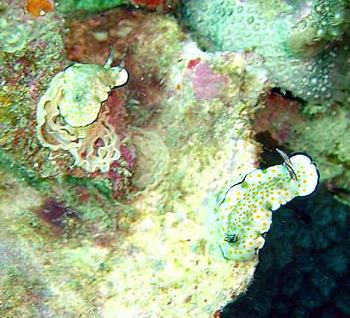
Hi Dr Rudman,
I spotted these nudibranches in the waters off Docmai, Phuket, Thailand. I've gone through a few books for their ID but no such luck yet.
Can you help?
Barbara Phua
babala.pan@pacific.net.sg


Dear Barbara,
I am pretty sure this is Risbecia ghardaqana. It was previously known only from the Red Sea but we now have records on the Forum of this species and the very similarly coloured Risbecia pulchella from both Thailand and Indonesia. It is a very useful record, helping to comfirm the distribution of this species
Best wishes,
Billl Rudman
Re: Risbecia ghardaqana
November 1, 2000
From: Gordon T. Smith
Dear Bill,
The examples I found in Musandam were around 5cm long at a depth of 15m, water temperature was 29C I do not appear to have any shots showing the foot, however I also do not recall noticing any purple edge on the foot. As for waving gills whilst moving, they were continually in the mating position, however the gills on both animals did retract on several occasions when I was photographing them.
I hope you enjoy your month's break in the field.
Best regards
Gordon
aquashot@emirates.net.ae
Smith, G.T., 2000 (Nov 1) Re: Risbecia ghardaqana. [Message in] Sea Slug Forum. Australian Museum, Sydney. Available from http://www.seaslugforum.net/find/3268Thanks Gordon,
The gill movement I was wondering about is a constant side to side flickering or waving of all the gills. It occurs in most species of Risbecia and Thorunna and some species of Noumea, and is a worthwhile thing to note if you notice it in any chromodorid you come across.
Best wishes,
Bill Rudman.
Risbecia ghardaqana from Oman
October 30, 2000
From: Gordon T. Smith

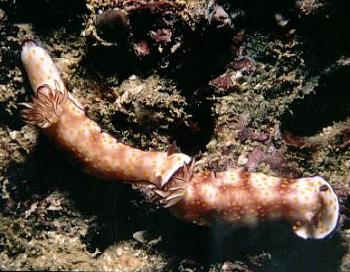
Dear Bill,
I have been diving the north part of Oman (Musandam)[NW Indian Ocean] recently fairly frequently with practically no sightings of nudibranchs until recently.
I found a pair mating three days ago, please see attached photo [UPPER PHOTO].
I would like to confirm identification as Risbecia pulchella, however they did look more like Chromodoris annulata without the purple rings around the gills and rhinophores.
I have included a photo of a pair of Risbecia pulchella that I photographed near Muscat (Oman) 2 years ago.
Gordon T. Smith
aquashot@emirates.net.ae
Smith, G.T., 2000 (Oct 30) Risbecia ghardaqana from Oman. [Message in] Sea Slug Forum. Australian Museum, Sydney. Available from http://www.seaslugforum.net/find/3256Dear Gordon,
This is an interesting find. In the western Indian Ocean there are at least three similarly coloured yellow-spotted chromodorids, two of which you mention in your message. Both those species have quite a wide Indian Ocean distribution, but the third, Risbecia ghardaqana is known only from the Red Sea. While I agree that the pair of animals in your lower photo from Muscat are R. pulchella, I suspect the mating pair from Musandam are Risbecia ghardaqana.
The yellow spots seem to be a bit small for R. ghardaqana but they are proportionally quite a bit larger and less densely spaced than in R. pulchella.
I would be interested in seeing a photo of the foot, if you have one, to see if it has a purple border. I would also like to know if you remember if the gills wriggled rhythmically as the animal crawled along. As with any photos you send to the Forum, I would be interested in some idea of size. As I am about to leave for a month's collecting, I will not be able to respond to any reply immediately, but anything you send will not be lost. It will just sit waiting patiently for my return. Good luck with sea slug hunting in Oman. There is little known from the region and any information and photos would be welcome.
Best wishes,
Bill Rudman.
